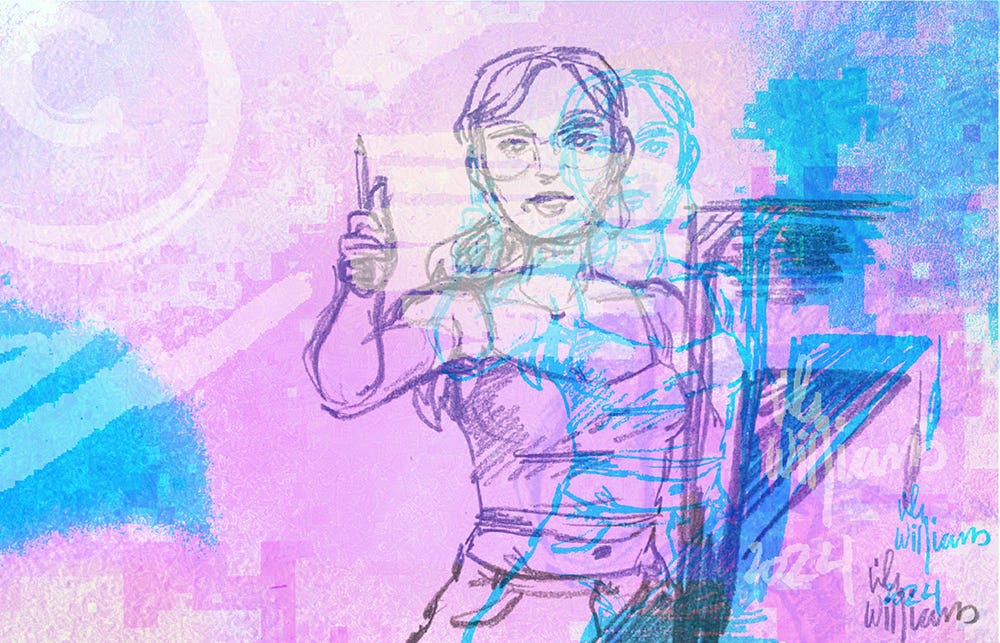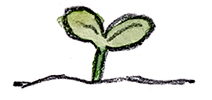The Guardian’s election coverage art is exclusively being made by hand.
Artists are fleeing Instagram en masse due to Meta’s AI policies and saying they “feel powerless” as everything online is believed to be scrapable by AI.
George R.R. Martin and 17 other top authors are suing OpenAI.
Artists sue Google in landmark AI case.
Chicago-based print studio, Sunroom, has started sending monthly Risograph prints by snail mail.
These are just a selection of cool things I’m seeing right now as artists push back on Artificial Intelligence infringing on their copyrights. AI should fear art copyright laws and the ego of tech millionaires will be their downfall.
What does this mean for art?
With more and more artists questioning what the future looks like for their art online, many are questioning if their art should be online at all (this author included). What was once viewed as a free marketing tool, has proven not to be free at all. Everything has a price and the cost here has proved to be art theft.
A brief history of art
History of Illustration by Susan Doyle (Anthology Editor) , Jaleen Grove (Anthology Editor) , Whitney Sherman (Anthology Editor). Published by Bloomsbury publishing in 2019.
The printing press and mass-print technology existed in Asia long before the Gutenberg printing press. However, when Europeans got ahold of the new technology by way of the Gutenberg printing press in 1439, the way art was digested changed forever. Broadsides were printed illustrated leaflets that were often used for political or religious propaganda. The pieces of artwork-lined paper paved the way for books and posters to be printed and consumed by the masses. Commercial illustration bloomed alongside the fine art of the Renaissance as a less valuable, more financially motivated art form.
The 1800s ushered in an era of new illustrators as the industry for printed books boomed. The early 1900s charted new territory for mass advertising in newspapers and catalogs. As animation took off in the 1930s, artists unionized and paved a path for moving artwork. The 1950s and 60s saw a rise in advertising art as artists found ways to make a substantial living on their creative practices through in-house and freelance advertising gigs. As art moved through the movements in an ever-industrializing world, we got Impressionism, Post-Impressionism, Cubism, Dadaism, Arts and Crafts, Modernism, Art Noveau, Expressionism, Pop Art, Post-Expressionism… until we landed where we are now in a Post Modern world.
For a long time, we have stayed stuck in a post-modern art world. Advertising art still exists but hasn’t become anything new, editorial illustration is a dwindling field, book illustration is stagnant, graphic design and illustration careers have blended into one, and animation executives’ greed is slowly trying to replace artists with AI. Since the 1980s, when Post Modernism, came to be full force, artist’s income has not increased. I know this because I did the research into it in 2021 and just a few years later, artist pay is still stuck in the 1980s.
We were due for a shakeup
Like any good art movement, we were due for a shakeup inspired by technology.
The Arts and Crafts movement (one of my personal favorites) was inspired by the Industrial Revolution and how an increasingly mechanical world felt like a harsh contrast to the beauty found in nature. Through the Arts and Crafts movement, we got American bungalows, The Gamble House, Strawberry Theif, and Tiffany and Co.
Right now we are facing another industrialization of our world - the Artificial Intelligence Revolution. This is a movement based on the labor of educated creatives whose work is being stolen, uncredited and unpaid for, and their jobs are being replaced by prompters and machines. Just like in the Arts and Crafts movement, we are due for a 180 pushback from artists…
The opposite of virtual and accessible is real life and inaccessible.
Can’t see this artist’s work online? Great, you can see it at a gallery in Jackson Hole, Wyoming and that’s it. Want to buy this artist’s comics? Fantastic, you can go to a bookstore and buy their Zines and Graphic novels. Want to be a part of this artist’s mailing list? Wonderful, you can subscribe to get prints in the mail each month and nothing to your already bulging inbox.
Digital decrease
The more digital art we have that is indistinguishable from AI, the more uneducated spectators will want to see art that looks handmade. AI art will cheapen art that looks digital. Even now we are seeing Disney’s classic digital animation style not hitting the same and Disney is suffering giant losses at the box office. While other more hand-created-looking indie animation is currently enticing audiences. Art is moving analog and the rise of AI will only move the needle faster.
This is exciting and I feel hopeful
I really mean it. When something big happens to push the art conversation to new heights, there is a boom of creativity and fresh ideas. Being a student of art means I’ve gotten sick of the post-modern discussion and I’ve been chomping at the bit for what’s to come for a while.
While illustration and animation are not “less than” fields, they are more mainstream and often get lumped into that category by fine artists and fine art critics due to their mass-market appeal. Social media has only furthered the process by making this art more accessible to anyone and everyone at the tips of their fingertips. If you have a phone and you want to access your favorite Disney visual development artist’s work — you can. Or rather, you could…
Gone will be the days of artists having huge follower counts, but it will mean artists can have a dedicated group of supporters who are willing to show up. Whether that be in spaces like this, RSS feeds, physical mailing lists, in-person gallery shows, or book launches. I think the art world is about to change for the better and an intimate, in-person, analog way will be the future forward.
Read more of my thoughts on AI
Keep reading with a 7-day free trial
Subscribe to Planting Seeds to keep reading this post and get 7 days of free access to the full post archives.




